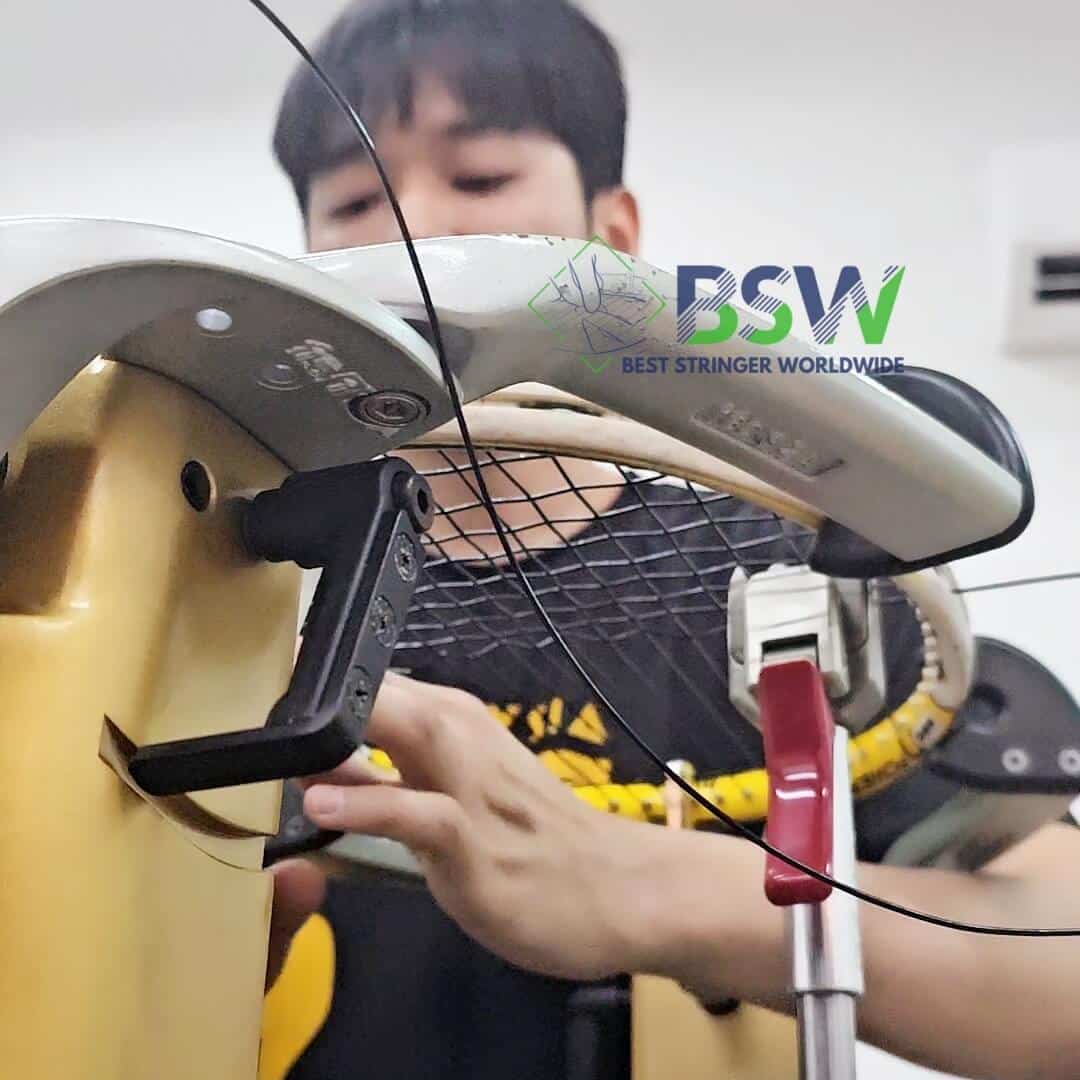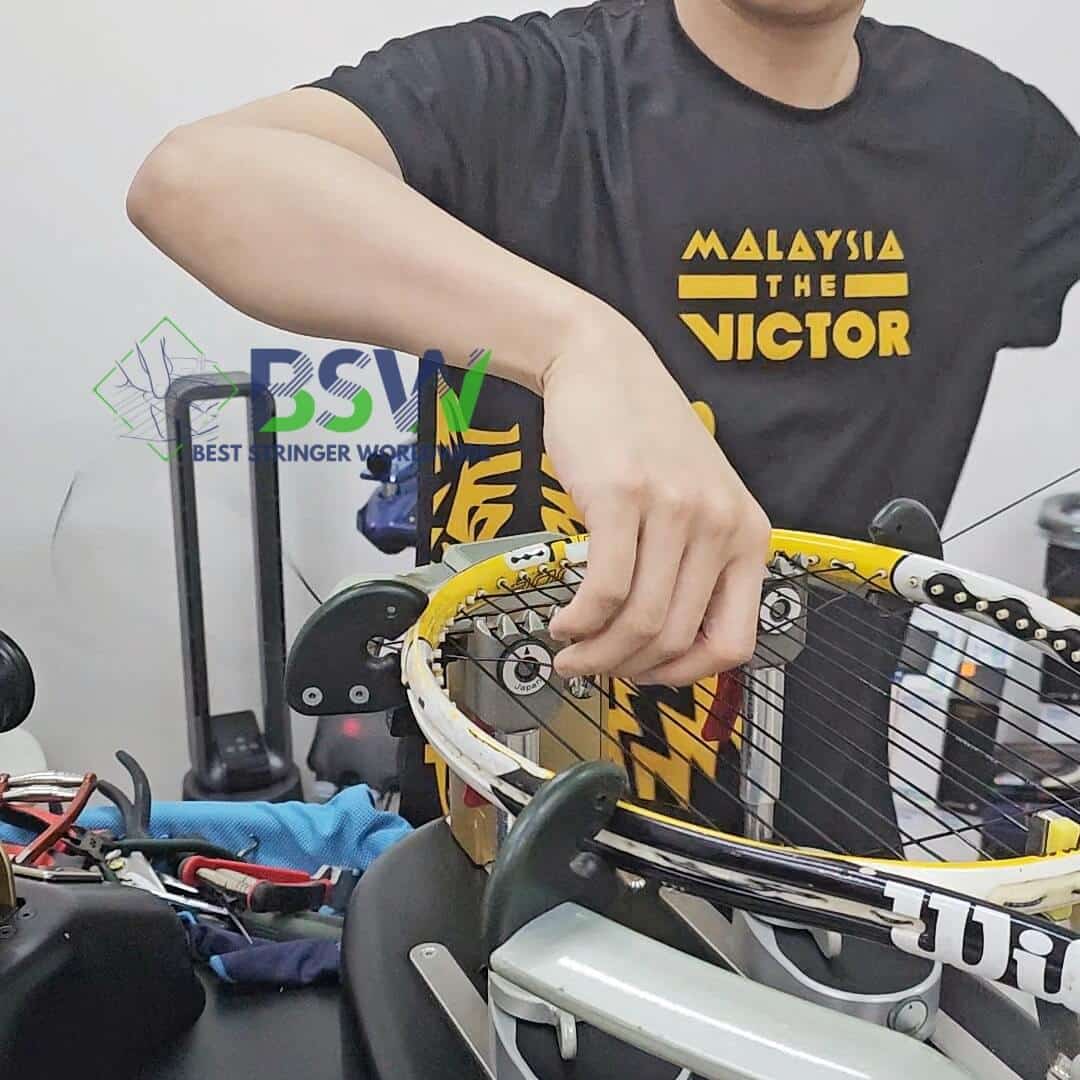Explore the intricacies of tennis racquet stringing, from tension selection to string longevity. Learn expert techniques to enhance your game and extend string life with Best Stringer Worldwide’s comprehensive guide.
Tennis Racquet String Tension Simulator
At Best Stringer Worldwide (BSW), we’re committed to helping stringers and players improve their skills and knowledge. In this comprehensive guide, we’ll dive deep into the world of tennis racquet stringing, exploring tension selection, string durability, and advanced techniques to enhance your game.
Test Your Knowledge: Tennis Racquet Stringing Quiz
Before we delve into the details, let’s test your current knowledge with a quick quiz:
Test Your Knowledge: Tennis Racquet Stringing Quiz
1. What is the recommended starting tension range for beginners using nylon strings?
2. How often should a player who plays twice a week restring their racquet in a year?
3. What is the main advantage of hybrid stringing?
Now that you’ve tested your knowledge, let’s explore the intricacies of tennis racquet stringing in more detail.
Choosing the Right String Tension for Beginners
Selecting the appropriate string tension is crucial for players of all levels, but it’s especially important for beginners. Here’s what you need to know:
- Nylon Strings: For beginners or players unsure about their preferred tension, start with 54-55 pounds (24.5-25 kg). This range provides a good balance of power and control for most players.
- Kevlar or Polyester Strings: Due to their lower elasticity, consider reducing the tension to 50-51 pounds (22.7-23.1 kg) when using these materials.
- Fine-tuning: If control isn’t an issue, you can experiment with lower tensions to achieve better power, feel, and spin effects.
Remember, these are starting points. As you gain experience and participate in tennis racquet stringing courses, you’ll learn to fine-tune your tension preferences.

When to Restring Your Racquet
Many players mistakenly believe they only need to restring when the strings break. However, regular restringing is crucial for maintaining optimal performance. Here’s why:
- Tension Loss: Strings begin to lose tension as soon as they’re installed. Even if the strings haven’t broken, their performance degrades over time.
- Performance Impact: Loose strings can lead to decreased control and potential arm injuries due to increased shock transmission.
- Restringing Frequency: A good rule of thumb is to restring your racquet N+1 times per year, where N is the number of times you play per week. For example, if you play twice a week, you should restring at least three times a year.
Understanding String Bed Dynamics
The string bed’s dynamic elasticity plays a crucial role in racquet performance:
- Energy Absorption: When a ball impacts the strings, the string bed deforms, absorbing energy.
- Energy Return: During the hit, the absorbed energy is transferred back to the ball, propelling it forward.
- Elasticity and Power: Higher dynamic elasticity leads to greater deformation and more energy return, resulting in increased power.
- Performance Degradation: Over time, strings lose their elasticity and comfort, resulting in a “dead” feeling and reduced power.
Tennis String Comparison Table
| String Type | Durability | Power | Control | Spin Potential | Comfort |
|---|---|---|---|---|---|
| Nylon (Synthetic Gut) | Medium | High | Medium | Medium | High |
| Polyester | High | Low | High | High | Low |
| Natural Gut | Low | High | Medium | Medium | Very High |
| Multifilament | Medium | High | Medium | Medium | High |
| Kevlar | Very High | Low | High | Medium | Very Low |
Factors Affecting String Durability
Several factors contribute to string breakage and wear:
- Racquet Frame Hardness: Modern racquets often use stiffer materials, which can lead to more frequent string breakage, especially on off-center hits.
- String Movement: Looser string beds allow for more string movement (known as “string creep”), which can cause notching and eventual breakage.
- Playing Style: Players who use a lot of spin may experience more frequent string breakage due to increased friction on the strings.
- String Gauge: Thicker strings (lower gauge numbers) are more durable but offer less feel. A 16G tennis string typically weighs 15-20 grams, while a 22G badminton string weighs only 4-5 grams.
Tips to Reduce String Breakage
To help your clients extend their string life, consider these recommendations:
- Use thicker strings or single-core strings for increased durability.
- Check and replace grommets regularly to prevent premature string wear.
- Consider using string savers to reduce friction between strings.
- Experiment with more durable string materials.
- Try hybrid stringing for a balance of durability and performance.
Advanced Stringing Techniques: Hybrid Stringing
Hybrid stringing involves using different strings for the main (vertical) and cross (horizontal) strings. This technique can offer a balance between durability and performance:
- Main Strings: Use more durable materials like polyester or Kevlar for the vertical strings.
- Cross Strings: Opt for more elastic materials like natural gut or thinner nylon for the horizontal strings to enhance feel and power.
When using hybrid stringing, reduce the overall tension by about 10% compared to your normal tension to compensate for the stiffer, more durable main strings.
The Importance of Professional Stringing
As a professional stringer, it’s crucial to educate your clients about the importance of proper stringing:
- Performance: Well-maintained strings ensure optimal racquet performance.
- Injury Prevention: Proper tension and regular restringing can help prevent arm injuries.
- Cost-Effectiveness: While it may seem counterintuitive, regular restringing can be more cost-effective in the long run by preserving racquet performance and preventing damage to the frame.
Continuous Learning and Improvement
The world of tennis racquet stringing is constantly evolving. To stay at the top of your game as a stringer, consider the following:
- Stay Informed: Keep up with the latest racquet technologies and stringing techniques.
- Attend Workshops: Participate in tennis racquet stringing courses to refine your skills.
- Seek Certification: Pursue a tennis stringing certification to validate your expertise.
- Engage with Players: Regularly communicate with players to understand their needs and preferences.
By committing to ongoing education and possibly obtaining a tennis racquet stringing certification, you’ll be better equipped to serve your clients and adapt to new trends in racquet design and stringing technology.
Tennis String Life Calculator
Mastering the art of tennis racquet stringing is a continuous journey of learning and improvement. By understanding the intricacies of string tension, durability, and advanced techniques like hybrid stringing, you can significantly impact a player’s performance and enjoyment of the game.
Remember, the perfect racquet setup is a combination of the right strings, appropriate tension, and a good match to the player’s style. As a stringer, your expertise in these areas can make a real difference in your clients’ game.
At Best Stringer Worldwide (BSW), we’re dedicated to helping stringers and players improve their skills and knowledge. Whether you’re looking to enhance your stringing techniques, choose the perfect string setup, or pursue a tennis stringing certification, we’re here to support your journey in the world of tennis.
This comprehensive guide on tennis racquet stringing is brought to you by Best Stringer Worldwide (BSW), your trusted source for tennis racquet stringing courses, racquet stringing courses, tennis stringing courses, and tennis stringing certification. Our mission is to empower stringers and players with the knowledge and skills they need to excel in the world of tennis.

About Best Stringer Worldwide
Best Stringer Worldwide is a comprehensive badminton and tennis stringing education program. We provide in-depth training on stringing techniques, racquet technology, and player-specific customization. Our curriculum is designed to help stringers understand and meet the needs of all badminton players, from casual enthusiasts to competitive athletes.
Read More